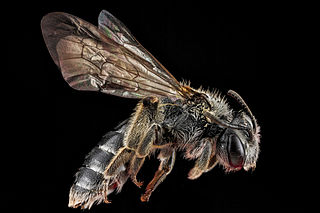
Halictidae is the second-largest family of bees with nearly 4,500 species. They are commonly called sweat bees, as they are often attracted to perspiration. Halictid species are an extremely diverse group that can vary greatly in appearance. These bees occur all over the world and are found on every continent except Antarctica. Usually dark-colored and often metallic, halictids are found in various sizes, colors and patterns. Several species are all or partly green and a few are red, purple, or blue. A number of them have yellow markings, especially the males, which commonly have yellow faces, a pattern widespread among the various families of bees. The family is one of many with short tongues and is best distinguished by the arcuate basal vein found on the wing. Females in this family tend to be larger than the males. They are the group for which the term 'eusocial' was first coined by entomologist, Suzanne Batra.

Tyler's tree frog or the southern laughing tree frog is an arboreal species of tree frog. It is native to eastern Australia where it occurs from south-eastern Queensland to the southern coast of New South Wales. It is generally a coastal species and is not found inland.

The genus Agapostemon is a common group of Western Hemisphere sweat bees.

Agapostemon texanus is a species of bee found in North America. Commonly known as the metallic green sweat bee or the Texas striped sweat bee, it varies greatly in its appearance, with variations in color and in the amount of black markings on the legs.

Agapostemon melliventris, the honey-tailed striped sweat bee, is a species of sweat bee in the family Halictidae.

Agapostemon virescens, the bicolored striped sweat bee, is a species of sweat bee in the family Halictidae. It is found in North America, and is the official bee of the city of Toronto. Like other species in its genus, A. virescens nests underground, in aggregations wherein multiple females share a single burrow.

Agapostemon angelicus is a species of sweat bee in the family Halictidae native to North America. Unlike apid bees, members of the Halictidae family are not honey-producers, although they still are pollinators.

Agapostemon sericeus, the silky striped sweat bee, is a species of sweat bee in the family Halictidae.

Agapostemon coloradinus is a species of sweat bee in the family Halictidae.

Nomada articulata is a species of nomad bee in the family Apidae. It is found in North America. It is a parasite of Agapostemon sericeus bees.

The Virginia miner bee is a species of miner bee in the family Andrenidae. Another common name for this species is the Virginia andrena. It is found in North America.
The Canada miner bee is a species of miner bee in the family Andrenidae. Another common name for this species is the Canada andrena. It is found in North America.

Jaera is a genus of isopods in the family Janiridae. There are more than 20 described species in Jaera.

The cloudy-winged miner bee is a species of miner bee in the family Andrenidae. It is found in Central America and North America.

Augochloropsis is a genus of brilliant metallic, often blue-green, sweat bees in the family Halictidae. There are at least 140 described species in Augochloropsis.

Agapostemon femoratus is a species of sweat bee in the family Halictidae.

The hairy-belted miner bee is a species of miner bee in the family Andrenidae. Another common name for this species is the hairy-banded andrena. It is found in North America.

Agapostemon splendens, the brown-winged striped sweat bee, is a species of sweat bee in the family Halictidae.
Agapostemon obliquus is a species of sweat bee in the family Halictidae.

Agapostemon nasutus is a species of sweat bee in the family Halictidae.

















